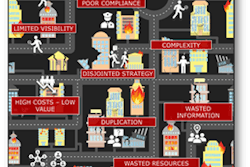
In our last aricle, we looked at what non-financial aspects should be included in your business case and how important they are to getting the business case approved. This article looks at the process of building the business case from a financial point of view.
The financials are, of course, an integral part of any business case and need to be calculated based on a level of detail that instils confidence in the key decision makers. It is hugely important that your board and executives can see that any numbers you include are both realistic and based on your own business data. Your (previous) analysis of current and future business processes will be incredibly useful here.
Business cases that get approved typically contain the following financial information:
· As-is cost breakdown
· Spend analysis
· Future-cost breakdown
· Procurement related benefits
· Invoice processing cost reductions
· People benefits
· Overall return on investment (ROI) and net present value (NPV).
As-is cost breakdown
Your as-is cost breakdown should measure the costs involved in running your current procure-to-pay processes, and include details around:
· The people time involved in executing the process – use your existing process research to map out the time taken for each task and the roles involved in completing them. You should aim to get a fully loaded cost per hour for each the roles (this should include the persons salary, on-costs, etc)
· The cost of current infrastructure and software – utilizing the technology map that you created earlier, you should be able to assign the direct (e.g., licence) costs involved and the indirect costs (e.g., platform support) of the current technology involved in procure-to-pay processes.
Spend analysis
An important and often forgotten part of any business case for transforming procure-to-pay projects is analyzing your current spend in as much detail as possible. Most organizations will likely only have accounting level information for each of their transactions. While you might think that this gives you the level of detail that is required, you are missing several key pieces of information that will give you a clear picture of where your money is being spent and on what.
Any spend analysis should be able to answer the question: where are we spending our money? So, your spend analysis should:
· Analyse at least 80% of your spend by dollar amount
· Be based on extracted spend data for the last 12 months
· Be mapped by supplier, business unit/location
· Map out the commodity that each transaction is for (use a combination of GL account code and spend description to identify this)
· Identify what was contracted spend vs non-contracted spend (this should be conducted at a transaction level rather than a supplier level to ensure accuracy)
This will give an accurate view on where your business is spending its money, with who, on what, and whether that spend is managed or not (i.e., contracted spend vs non-contracted spend).
Future-cost breakdown
Your future-cost breakdown should capture the costs involved with implementing the proposed new technology and processes. Align this analysis with future process and transformation roadmap, so that you have absolute clarity over the delivery methodology, delivery timeframes and the resources required to have an accurate view over, at least, a 3-year period. The key here is to get an understanding of the total cost of ownership of your new technology and processes. These future costs should include:
· Software costs
· Change management costs
· User training/support costs
· Integration/s cost
· External system implementation costs
· Operating model change costs (e.g., new staff salaries etc)
With an accurate as-is cost breakdown, spend analysis and a future-cost breakdown, you should have all the information to understand the costs involved in keeping current processes, the cost of implementing proposed technology and future processes and a clear view on where and how you are spending 80% of your expenses.
Procurement-related benefits
The other side of a financial business case are benefits. Understanding the return that you will get from undertaking this project. Procure-to-pay projects are rare, in that many of the benefits, as well as the costs, are completely measurable and predictable. Let’s start with procurement related benefits.
Procurement-related benefits are driven from greater systematic control over spend and data-driven spend insights. You should have an idea of which commodities you are spending most of your money on from spend analysis. You can then identify:
· Based on this data analysis what opportunities are there to increase leverage over current suppliers – this could be through supplier consolidation, minimising non-contract spend etc).
· What commodities are you spending a lot of money on that are currently not under contract? This gives a great opportunity to negotiate preferential rates based and drive cost savings.
· Of your contracted spend, what contracts are due for renewal over the next 3 years and how more effective could your procurement teams be armed with real-time, accurate spend data?
These procurement-related benefits can add up quickly, as research earlier shows, cost savings benefits could range up to 15% in some spending categories. Take a conservative view for each of your categories based on your confidence of being able to drive cost savings, suggested rates would be:
· Low confidence – 1-2% cost savings
· Medium confidence – 3-5% cost savings
· High confidence – 6-8% cost savings.
Invoice processing-related benefits
There are three main areas that you can leverage through a source-to-pay transformation that will drive the cost of processing invoices down:
· Reducing time spent on processing invoices through automation - with the right technology and processes you can cut a lot of unnecessary manual work operations and button pushing through e-invoicing, purchase order matching and fraud detection.
· Digitize and automate approval workflows - through pre-approval of spend with implementing purchase orders makes the approval of invoices largely automated and where exceptions required, the approval workflow is automatically identified and routed.
· Drive focus into process accountability and efficiency - providing key efficiency insights into the whole invoice processing workflow you can baseline performance and improve over time reducing processing and handling time.
To calculate the invoice processing related benefits, assign time and roles to your future-process that you identified earlier utilising the average loaded salaries that you calculated. The invoice processing costs related to your future process can then be subtracted from the cost your as-is related costs.
People-related benefits
The people-related benefits are a little more speculative as they are going to be harder to measure accurately. The basic premise is seeking to assess what benefit can be achieved from staff spending more time on value-generating activities rather than admin work.
As an example, imagine you have frontline staff or management who are spending 2 hours a week on administrative tasks to support your existing procure-to-pay processes (you can measure this from your existing process map work completed earlier). With your new process, this administrative burden drops to half an hour a week, with that extra 1.5 hours a week what extra value can your front-line staff or management create? Can they do more trying to get more customers, upsell customers or focus on customer retention?
It’s likely that through your stakeholder interviews you will have already got some insights into what their current time spent on the procure to pay process is stopping them doing, use those insights to identify an expected benefit of your people focussing on more value adding activities.
This could result in any of the following:
· Percentage increase in profitability
· Percentage increase in sales
· Percentage decrease in churn/wastage
· Percentage increase in productivity.
An additional, perhaps unmeasurable, benefit that will come from staff focussing on more value-adding activities is improving staff morale – your team feeling that they are having a greater impact by focussing on activities that they are seeing move the dial.
Calculating ROI and NPV
Once you’ve completed this analysis, you should have the following figures:
· Current costs to run procure-to-pay process per year (CC)
· Procurement-related savings per year (PS)
· Future costs to run procure-to-pay process per year (FC)
· Implementation costs (IC)
· People-related benefits per year (PB)
From this you’ll be able to calculate your expected return on investment percentage over 3 years through the following formula:
Calculate total Costs: IP plus ((FC minus – CC) multiply by 3)
Calculate Total Benefits: ((PS plus PB) multiply by 2*)
ROI: (Total Benefits minus Total Costs) divided by Total Benefits
*We assume that benefits will only be realized Year 2
Mapping out each of the figures above into each year to calculate an annual loss/benefit will enable you to then calculate the net present value of the investment utilizing a NPV formula.
This rounds out the financial aspects of your transformation business case, which when combined with the non-financial aspects, will help create a very powerful transformation story that executives will struggle to ignore. In the final part of the series, we will look at the steps you need to take after preparing your business case to ensure that the value you’ve detailed in your business case is actually delivered.
CLICK HERE to read Part 1.
CLICK HERE to read Part 2.
CLICK HERE to read Part 3.
CLICK HERE to read Part 4.














